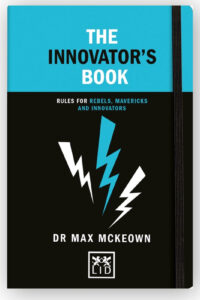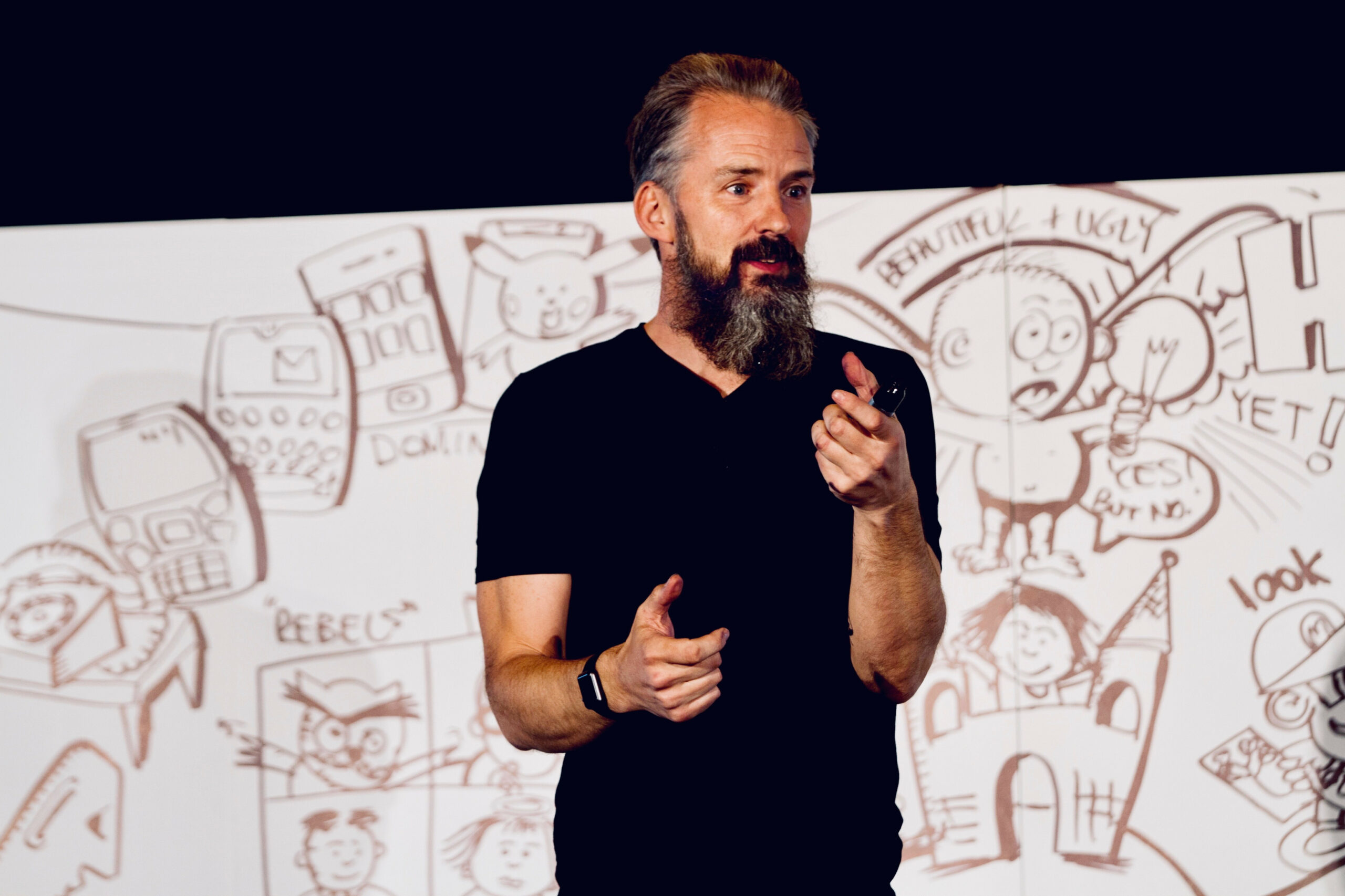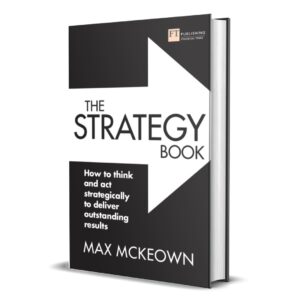Create the Best Possible Future
Are you confident in your company’s future?
How do you rate your business strategy?
Is your team engaged in the creation of your plan?
Are you staying ahead of the competition and creating a sustainable advantage?
“Strategy is about shaping the future.”
That’s the opening line in The Strategy Book by Max Mckeown. In a logical, straightforward manner, Max walks readers through strategic principles and best practices in a way that educates the novice and the well-practiced strategist alike. Whether you are a CEO or a new team leader, Max provides helpful tools and checklists to improve your strategic plan.
Max Mckeown is an author of several best-selling, award winning books. He’s also a sought-after speaker on subjects ranging from competitive advantage to strategy to leadership. He holds an M.B.A. and Ph.D. from Warwick Business School in England.
I had the opportunity to talk with Max about strategic best practices.
What’s the biggest misconception about creating a strategy?
Strategy isn’t a document. Some people believe that it is. And that’s probably why so many hard-working people roll their eyes when the strategy word is mentioned. Specifically, strategy is not leaders spending a million dollars on thick documents produced by outsiders to which insiders must align.
You’ve met thousands of managers and leaders in businesses around the world. When you meet a team, what attributes are present when you find an exceptionally high-performing team?
Strategy is about shaping the future. Perhaps this is why the roll-up-your-sleeves, get-things-done kind of people are often impatient with anything remotely connected to the word strategic. They want results. They tend to ignore the want-to-see-the-bigger-picture kind of people they see as daydreamers.
In the best teams, these two groups come together to create something far more powerful. They tend to understand that brilliant strategy is deeply, profoundly practical because it is the shortest, or best, route between desirable ends, something you really, really want, and available means, what you actually have to work with. They ask how we can get where we want to be, better, faster.
So when doers and thinkers appreciate each other, their natural talents blend together into something much more effective. Together they become hybrid thinking-doers and doing-thinkers who ask questions and get things done – but rather than doing the right thing badly, or the wrong thing well, they do the best thing better. With one group looking further into the distance or into the future giving perspective to those who see the details closer to home, today or next week. That high performing blend tends to adapt fastest in the short and very long term.
What’s the difference between a strategist and a planner?
Planners, and this is a stereotype, tend to spend their time producing spreadsheet forecasts, things-to-do checklists, and complicated project diagrams. They assume things will be like they were in the past, plus a little bit better or worse, more or less. As a result, their forecasts are extrapolated from the immediate, most obvious pattern. They are causal thinkers. Their things-to-do checklists focus on what has to be done to do what we were already doing. Their projects focus on efficiency.
Strategists, and these vary as well, tend to look further, deeper, and longer at everything. They are trying to figure out how the game that they are in works and they are driven to find new ways of playing the game rather than playing the obvious game with obvious rules. They approach strategy as a test of imagination, creativity, cunning and courage rather than as a set of tasks to be completed. They want to succeed, but they also want to transcend the constraints of the situation, play their own game, do something that matters, and solve the puzzle with style.
One problem with the planner’s perspective is that it does not cope well with rapid, chaotic or unforeseen change when the assumptions in their neat planning documents are overtaken by events or the competition. Another problem is that it does not escape the ways of thinking that have guided the group or organization in the past. More of the same doesn’t cope with a situation that is ever more different, and doing exactly what has been done in the past cannot improve the future.
One of your chapters is titled “Reacting is as Important as Planning.” What’s the difference between this good-reacting versus, “Let’s reopen the strategic plan every time something happens”?
That’s a smart question that should be asked more often. Reacting matters as much as planning, perhaps even more. The usefulness of a plan is the way it can shape action now to shape the future later. Without action nothing in the plan ultimately has any power to actively, deliberately influence the way things are in the future. Without action the plan is powerless, impotent and an irritating waste of time.
If people know the strategy, then they can try to react to events in ways that are more likely to make the strategy work. If they think strategically, they can react by considering whether new actions or approaches are needed to make the existing strategy work or whether a new strategy is needed to cope with a new situation or new opportunity that was not considered at the time that the strategy was written.
Success is often a series of clever reactions to great unplanned opportunities. The first designer at IKEA reacted to not squeezing a table into his car by inventing flat pack furniture. Nintendo reacted to a smart inventor on the factory floor by transforming from playing card manufacturer to a global electronics brand. Some software guys reacted to the failure of their original product, a competitor to iTunes, by dreaming up Twitter during a brainstorm in a children’s playground.
Three Reactions that Don’t Work
There are three reactions that don’t work. Dumb reactions don’t follow the strategy because people don’t understand the strategy. A customer is treated badly by customer service people because they have no clear rule to follow when a new situation arises. The rule book can’t cover everything, so we rely on people to understand the strategy logically and emotionally – particularly in their work.
Second, Insane reactions continue to do what has always been done even when the circumstances have clearly changed. Leaders ignore evidence and rely on statements about willpower or decisiveness. They may minimize the impact of what’s happening, attack messengers who bring them bad news or deny everything. Examples here include Blockbuster, Borders or the makers of Blackberry phones.
Third, Slow reactions recognize that there might be a problem with the strategy so decide to start a new strategic planning process that is as uninspired, numeric and causal as the first strategy. But the worst part is strategy takes days, weeks and months to make timid, unadventurous steps which may be far too little far too late. These meetings don’t lead to action, improvement or learning. This has been the problem at HP, but also General Motors, Sears and Sony.
Far better are Insanely Great reactions that use the available means, including money, equipment, relationships, knowledge, talent, imagination and verve to find the goals that allow them to enjoy the success that means the most to them. This is entrepreneurial strategy, it uses what Saras Sarasvathy calls effectual thinking where we make, recognize and grab opportunities and vary the goal accordingly.
Most organizations have a strategy. What are the biggest mistakes most executives make in forming a strategic plan?
Strategy isn’t really a solo sport – even if you’re the CEO. So although different executives make different mistakes in forming a strategic plan, one of the most common big mistakes is to forget that strategy is an opportunity to make it clear that the talents, good-will, knowledge and best efforts of everyone in the organization are valued and needed. Brilliant strategy is a chance to encourage heartfelt collaboration and to find better answers than exist in the executive team.
Another mistake is to make strategy a one-time-each-year event rather than a continual learning journey. If strategic planning is something that we treat like income taxes, as something to be avoided, then we’re doing it a disservice. If strategy is painful, you’re doing it wrong. So keep your strategy short, focus on what it means and how it will allow you to get where you want to go. Make strategy fun. It’s not easy all the time, but fun, because it’s about creatively figuring out how to do great work and contribute something worthwhile. It doesn’t have to be a chore.
Of all the companies you’ve observed, who’s doing strategy right?
There are no hero companies. There are those who are doing something that works and those who are doing something that doesn’t work at the moment. So Facebook has done some insanely great strategy work because they have moved from great talents to creating and then grabbing astonishing opportunities. It’s entrepreneurial and it’s worked. The same could be said of IBM’s recent past when they have used big ideas to out-think and out-flank their competition. BMW is strategically smart. And TATA recognizes the need to adapt and do stuff that matters in a strategic way.
What are the common pitfalls in creating a strategy?
It’s tempting to plan before you think, rather than thinking before you plan. Strategy is about thinking your way from one place to a better place – as judged by you – it’s about imagination, or vision, first and planning second.
Strategists who don’t take time to think are just planners and miss out on threats that might kill you, changes that make your plan irrelevant, and opportunities not considered because you were too busy merging documents or creating slide decks.
All this thinking and looking at the big picture can get complicated and tiring. There can be so many things to consider that you don’t know what to do next or what you are trying to do or what is really going on. That’s why it’s important to simplify the big picture. A great strategist doesn’t get lost in the detail; you need to rise above it and provide a clear map to help others know where they are and what to do.
What role does culture play in creating competitive advantage?
A famous article once claimed that culture eats strategy for breakfast because it is much more important how people behave and interact than what strategy they follow. The problem with this view is that it often fails to understand either the nature of culture or the value of strategy. This is why I recently argued that brilliant strategy and culture should eat breakfast together. (See full article here)
Culture is about the personality and behaviors of a social group. It is the billion different ways that predict what a group of people are likely to do next. It is the manner, the flavor, the traditions, the norms, the attitudes that distinguish one group from another. This is culture. And it is both means and ends.
Culture can shape the kind of strategy that emerges, but it is not strategy. Strategy can shape the kind of culture that develops, but it is not culture. And the difference between the two means that they both matter – equally – to the survival and potential success of the group over the short, medium and long term.
When it really works, your people start to think and act strategically rather than having to wait for a strategic plan to be cascaded down from on high. When it really works, your people provide the competitive advantage that you wanted because they understand better than everyone else what you all want to achieve, why, and how.
You draw from so many sources in your books. What books are you currently reading?
There are stacks of books on my desk and lists of downloaded ebooks on my smartphone and tablet – I’m currently reading all of them along with academic papers. With non-fiction, I tend to chase my questions, like Alice with her white rabbit, until they introduce me to yet more interesting answers and even more fascinating questions. On the list is a book called Rebels in Groups all about the positive role of defiance and dissent, The Man who Mistook His Wife for a Hat by Oliver Sacks and Readings in Managerial Psychology by Leavitt, Pondy and Boje.
With fiction, I have become a fan of audiobooks from Audible – who just published my book Adaptability – and I’m listening to American Gods by Neil Gaiman narrated by the fabulous George Guidall. It’s a fascinating look at the nature of America and its relationship with a thousand earlier cultures from other times and continents.
For more information, see The Strategy Book.




